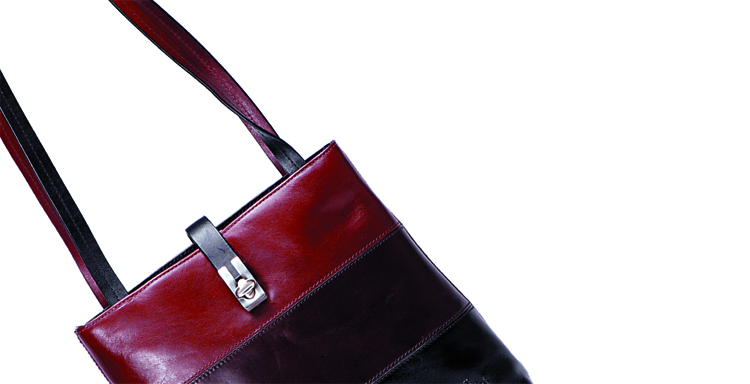Handbags have been around since the first caveman rolled a collection of arrowheads into a skin, but the modern fashion accessory has a much shorter history.
Egyptian tomb-paintings show people wearing decorated pouches hung from the waist, but in European literature the first mention is the 14th Century when pouches hung from the belts or girdles of both men and women, just as the sporran does today.
Developments over the years saw the merely practical take on a decorative role as well, with bags just for the carrying of things becoming luggage, and bags for the person becoming accessories.
The big driver for the development of what we know today as the handbag was the popularity of neo-classical clothing for women in the 18th Century. Far less voluminous than the clothing of the previous age, there was nowhere to put pockets, nor stout belts to hang things from, so the reticule was born. A vade mecum for the lady of fashion, it became an essential item, and each different occasion required its own reticule.
The era was also one of new freedoms for women – only for women of means perhaps, but new-found freedom nevertheless. Women traveled with minimal escorts, or with other women, and had the spending of their own money. Women in Society called upon one another, and had to have to hand the necessaries to repair damage to face powder, rouge and patches. Reticules contained all these, and a card case, scent, smelling salts and a fan. Compartmentalisation meant one could store spectacles and cosmetics separately, and the evening bag of course had a space for the opera glasses.
The term “handbag” was originally coined to describe hand-carried luggage bags usually carried by men. Multi-divided, with straps and locks, these created a new source of inspiration for the reticule makers, who borrowed the term for their female clients.
Jewellers got into the act, and the 1900s saw precious metal mesh bags, set with semi-precious stones and extravagant art-deco metal designs.
Fully mainstream now, the handbag developed in line with the fortunes of the century: wartime austerity followed Edwardian frippery; plastic and wood followed metal, silk and leather; the great fashion houses followed the bespoke designer with the single shop.
Traditions of workmanship and design have not been abandoned however. The qualities a woman looks for in a day-to-day bag: quality, shape and style, workmanship, practicality – these must all be there, as this is the start of a long relationship. The timelessness of the design and the best materials and workmanship mean a keeper – a bag used and re-used.
The evening bag – here look and coordination with the clothes chosen for the evening are important. The handbag is the accent that sets it all off, and there is usually a struggle between the perfect look and the evident cheerful absurdity of many designs.
Today’s handbag designer has to struggle to stand out. The big brands are ruthlessly copied, and it is the wise woman who knows her bag’s creator. Tons of mass-produced, poorly-designed flimsy dross have flooded the lower end of the market, with all-too disposable apologies for the real thing.
So what does today’s woman do to ensure value for money?
We asked Glenn Mitchell of Cellini. Cellini is a fully Australian brand, owned by a firm that has been in the handbag and leather business in Sydney since 1941. Glenn is chief designer, and it is his job, indeed his passion, to bring to the market the very best designs, made of the very best leather and fabrics, to the very highest of standards.
Originally a structural engineer, Glenn got into designing handbags through a family connection. “I could always figure out how a design had to be built”, he says. “It isn’t good enough to design something beautiful, it has to be built as well, and that is a skill that has stood me in good stead when designing handbags”.
“My designs have to satisfy several demands: first and foremost of these are the demands of the buyer, the shopper. What does she want this season? What will she want next season when the bags I am designing now will be delivered by the factory?
Then there are the practicalities: will this bag be easy to make? Will the cutting waste material? If the design depends upon a particular quality or type of leather, is a big enough supply assured? Will the bag cost so much to make that it can’t be sold at a reasonable price?”
The fashion business is risky and the vagaries of Mrs Jo Public are notorious. The leadtime for a design is months from concept to department store counter, and much can happen in a month. People might not be buying at all if the economy has stumbled, and fashion may have turned in an entirely unforeseen direction as it maddeningly can.
“The secret,” says Glenn Mitchell, “is to strive to create timeless designs that will weather such ephemera as changes in taste. Our customers appreciate it too. Who wants to be seen carrying last year’s bag? Our clients expect our designs to stay current for years, and reward us by buying our products again. Quality and workmanship and the finest materials are never out of fashion, and our distinctive style gives us the lead we need to maintain our position as Australia’s best”.
